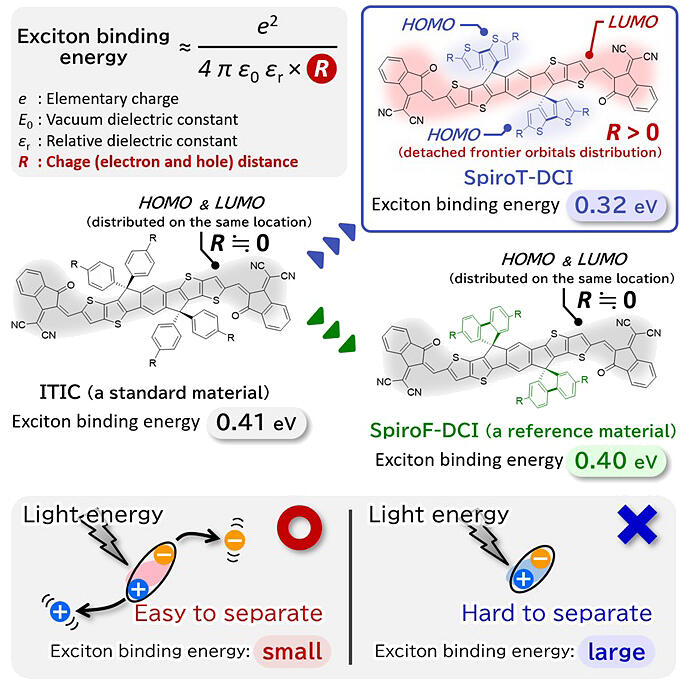Assistant Professor Seihou Jinnai and Professor Yutaka Ie of the Institute of Scientific and Industrial Research, Osaka University, in collaboration with Professor Akira Yamakata of the Graduate School of Environmental, Life, Natural Science and Technology at Okayama University, Professor Yasuhiro Kobori of the Molecular Photoscience Research Center at Kobe University, Professor Masahiro Higashi of the Graduate School of Informatics at Nagoya University, and their collaborators successfully reduced the exciton binding energy of organic semiconductor molecules by introducing a molecular design that spatially separates the frontier orbitals of organic semiconductor molecules. Bulk-heterojunction organic solar cells were fabricated using the newly developed organic semiconductor material. By virtue of the smaller exciton binding energy of the material, the fabricated solar cells exhibited better characteristics than those using conventional materials. It is expected that this discovery will clarify some of the guidelines for effective molecular designs, leading to the creation of new optical and electronic devices based on new driving principles. The results were published in the preliminary online edition of Angewandte Chemie International Edition.

Provided by Osaka University
The energy conversion efficiency of organic solar cells depends largely on the efficiency with which organic semiconductors absorb light energy and generate free electrons and holes, which are the source of electric current. Generally, owing to their smaller relative permittivity than inorganic semiconductors, such as silicon, negative and positive charges in organic semiconductors are strongly bound to each other through Coulomb attraction (exciton binding energy) even after absorbing light energy, making the generation of free charges difficult. This is one of the challenges for the advancements of organic solar cells.
The research group previously discovered that the exciton binding energy could be reduced by adopting a molecular design that increases the relative permittivity of organic semiconductors. Furthermore, it is expected that the exciton binding energy can be reduced by increasing the distance between positive and negative charges in the excited state (R) in the Coulomb's equation. However, no organic semiconductor materials have been developed with focus on the distance between charges in the excited state.
Normally, in an excited organic semiconductor molecule that has absorbed light energy, an electron in the highest-energy orbital (highest occupied molecular orbital, HOMO) among molecular orbitals occupied by electrons moves to the lowest-energy orbital (lowest unoccupied molecular orbital, LUMO) among molecular orbitals that are not occupied by electrons. In other words, the location of the HOMO in the molecule becomes positively charged and that of the LUMO becomes negatively charged.
In this study, by realizing a design that separates the spatial arrangement of the HOMO and LUMO within the molecule (a design that increases R), the research group developed an organic semiconductor molecule (SpiroT-DCI) with a smaller exciton binding energy than the conventional material ITIC. Bulk-heterojunction organic solar cells were fabricated using the developed organic semiconductor molecule as an acceptor to absorb light and PBDB-T as a donor to emit electrons. Consistent with the smaller exciton binding energy, the fabricated solar cell using the developed molecule exhibited better performance than those prepared utilizing conventional materials (ITIC) and comparative materials (SpiroF-DCI).
A prototype solar cell using the newly developed single-component film of SpiroT-DCI was fabricated as the power-generating layer. The fabricated prototype demonstrated a maximum quantum efficiency of 3.6% and was found to function as a single-component organic solar cell, although the energy conversion efficiency was small.
Ie said, "Exciton binding energy is a key parameter for improving the performance and exploring new functions of not only organic solar cells but also photoelectronics based on organic materials, such as organic photosensors and organic photocatalysts. We hope that the results of this research will serve as a reference for the molecular design of new photofunctional materials."
Journal Information
Publication: Angewandte Chemie International Edition
Title: Nonfullerene Acceptors Bearing Spiro-Substituted Bithiophene Units in Organic Solar Cells: Tuning the Frontier Molecular Orbital Distribution to Reduce Exciton Binding Energy
DOI: 10.1002/anie.202412691
This article has been translated by JST with permission from The Science News Ltd. (https://sci-news.co.jp/). Unauthorized reproduction of the article and photographs is prohibited.




